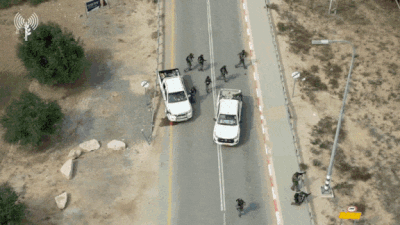[ad_1]

On October 7 last year, a day that would become one of Israel’s most tragic in recent memory, the nation found itself under siege. The day started like any other but by the end of that day, the region was reduced to a war zone, marking the beginning of a conflict whose repercussions still ripple across the middle east.
As Israel marked the one-year anniversary of the attacks, the IDF released previously unseen footage from the assault.The first video depicted troops from the elite Multidomain or “Ghost” unit in action at Kibbutz Re’im on October 7.
The second video showed the aftermath of the battle at Sderot’s police station, where Hamas had taken control and killed multiple officer, according to Times of Israel.
Here’s a look at how the horrifying day unfolded:
Festival that turned to tragedy
Set against the backdrop of fields around Kibbutz Reim, just beyond the Gaza border, the Nova music festival had begun its second day on October 7. Around 3,000 attendees had gathered for what was supposed to be a celebration of life and music.
But just after dawn, chaos erupted as Hamas unleashed a torrent of rockets from Gaza, raining destruction upon southern Israel. In mere moments, the festival became the target of one of the deadliest militant attacks in the nation’s history.
Watch: Drone video of Israel’s Nova music fest tragedy shows how Hamas brutally killed 260 Israelis
As the first rockets hit, panic spread among festival-goers. Some ran for their lives while others sought shelter behind vehicles, tents, and anything that could offer protection. But Hamas militants had already breached Israel’s heavily fortified security fence. Armed fighters streamed into the area on motorbikes, gunning down hundreds of attendees. At least 370 people lost their lives in the attack on the Nova rave, making it the deadliest scene of that fateful day.
Nation reels in shock
As the tragedy at the festival unfolded, similar horrors were playing out across southern Israel. Hamas fighters breached what many had thought to be Israel’s impenetrable “iron wall,” storming border towns like Sderot, Be’eri, and Ofakim. Civilians, unprepared for such an onslaught, found themselves barricaded in their homes, some retreating into bomb shelters, which now doubled as panic rooms. For many, it was a day of desperate phone calls, as loved ones tried to reach friends and family, hoping they had survived the barrage.
The death toll rose quickly. By the end of the day, over 1,200 Israelis had been killed—most of them civilians. Adding to the national trauma, more than 250 people were taken hostage by Hamas, their fates uncertain as Israel braced for its retaliation.
Retaliation: ‘We are at war’
By that afternoon, Prime Minister Benjamin Netanyahu addressed the nation in a hastily convened meeting in Tel Aviv. His words were direct and somber: “We are at war.” Israel’s military wasted no time in launching a full-scale retaliation. Airstrikes began to pound Gaza, and soon, the region was engulfed in smoke and fire.
What followed was a devastating military campaign from Israel, hitting targets by air, land, and sea. Gaza, already a densely populated and economically fragile region, bore the brunt of these attacks. By the time the dust had settled, more than 41,000 people—primarily civilians—had lost their lives in Gaza, raising international concerns over the scale of destruction.
A broader conflict brews
While Israel grappled with the immediate aftermath of the October 7 attacks, the broader implications of the day’s events can be witnessed till date. The violence on the ground escalated into a full-blown war, not just between Israel and Hamas but also with Hezbollah in Lebanon.
Israeli forces now faced an additional front in the north, where they engaged with Hezbollah militants. As tensions soared, all eyes turned toward Tehran, with fears that Iran, a longtime supporter of both Hamas and Hezbollah, might soon be drawn directly into the conflict.
For those gathered at Tel Aviv’s commemorative ceremony a year later, the anniversary of October 7 was a somber reflection on how quickly peace can turn into chaos as candles flickered.
[ad_2]
Source link







